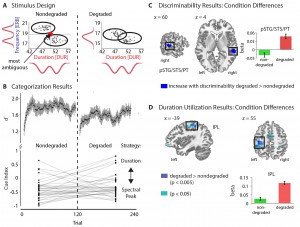
My year in science 2008 finds a satisfying ending by seeing the fruits of my colleague Dr. Frank Eisner’s (currently ICN / UCL) and my own yearlong efforts online.
Our opinion piece on how the problem of pre-lexical abstraction of speech in structures of the auditory cortex should be best approached is finally available as a beautiful and handy pre-print from Trends in Cognitive Sciences.
As a goody, I quote from the conclusions rather than the openly available abstract:
‘Behavioural investigations in speech sciences and computational modelling have led to a detailed understanding of how the speech perception system can be conceptualised. While this type of research cannot by itself produce a neuroanatomical model of speech processing, it should guide neuroscientific investigations by providing a theoretical framework.
Using the cognitive subtraction method, functional neuroimaging studies have broadly defined the neuroanatomy of pre-lexical processing. Multivariate neuroimaging techniques have the potential to study spectro-temporal encoding and abstraction of speech in more detail, and crucially, in a manner that can be related to results from other fields. […] We suggest that the output of these multivariate methods can serve as input to cognitive models of speech perception, in parallel to behaviour-based likelihoods that have been used in speech science, waveform-based likelihoods that can be extracted with automatic speech recognition techniques, or spike-timing patterns that have been observed in animal studies.
The integration of findings from all of these areas, and the latest technological developments within each of them, can lead to a testable, neuroanatomical model of pre-lexical abstraction.’
Feel free to mail me for reprints.
References
- Obleser J, Eisner F. Pre-lexical abstraction of speech in the auditory cortex. Trends Cogn Sci. 2009 Jan;13(1):14–9. PMID: 19070534. [Open with Read]
Speech perception requires the decoding of complex acoustic patterns. According to most cognitive models of spoken word recognition, this complexity is dealt with before lexical access via a process o […]


